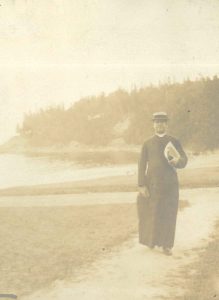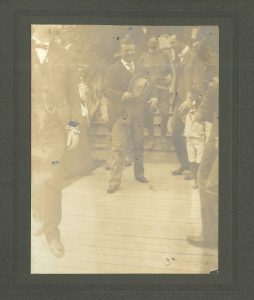This week’s post is guest-authored by Ronnie Georgieff, a graduate student in Library and Information Science at Catholic University.
Reverend John Talbot Smith LL.D. may have had a common name, but this Irish-American priest was anything but. He was a large, broad, solid figure. Over six feet tall, he was a “woodsman in a cassock,” some even calling him “the human icicle.” He is described as “utterly lacking in softness, never employed a caressing tone or phrase, and his impersonal Catholic viewpoint never relaxed or slackened or compromised.” Despite his intimidating figure, Smith was a practical joker, had a rather playful side to him, and a classic wit that could not be mistaken.

Smith was born in Saratoga, N.Y. on September 22, 1855 and was educated in the schools of the Christian Brothers in Albany, N.Y. and studied divinity at St. Michael’s College in Toronto, Canada. He was ordained to the priesthood on July 17, 1881. He was pastor of St. Patrick’s in Watertown, N.Y., pastor of Rouse’s Point, chaplain to the Christian Brothers at De La Salle Institute, chaplain of the Sisters of Mercy as well as pastor of Dobbs Ferry. Within the last year of his life, his health began to fail and on September 24, 1923, he passed away at the age of 68.

Outside of his priestly duties, Smith enjoyed the outdoors, which often inspired his writing. In his youth, the physicians had discovered in Smith a marked tendency of tuberculosis and prescribed a life in the pine woods and sleeping in a tent. So he became a missionary in the Adirondack region where he was well known by the woodsmen and lumberjacks. Soon after, he established The Boys Camp in Cliff Haven in 1898 as an adjunct to The Catholic Summer School of America. The Boys Camp was one of the first recreation camps for youth, which was greatly supported and highly revered by all who attended. Smith was also the president and trustee of the The Catholic Summer School of America for a number of years.
The outdoors, particularly the Boys Camp in Cliff Haven, in addition to the Catholic faith, Irish-Americans, social concerns especially in labor relations, housing and the theater, were big influences for his writing. He published many works, most notably “A Woman of Culture,” “Solitary Island,” “Saranac,” His Honor the Mayor,” “The Art of Disappearing,” which was reprinted under the title, “The Man Who Vanished” as well as “The Boy Who Came Back,” The Black Cardinal” and “The Boy Who Looked Ahead.” He also published articles in a number of prominent journals and newspapers such as the Dublin Review, the Catholic World, the Ave Maria, the Columbiad, and the Catholic Review of New York. He also succeeded Patrick Valentine Hickey, the editor and founder of the Catholic Review of New York, for 3-4 years. In addition, he was the founder and chaplain of the Catholic Writers Guild of America in 1919. His written works also include two volumes of sermons, short stories, histories, lectures for on literature at Notre Dame University, Indiana and plays.

Smith had quite a passion for theater, and unfortunately, lived during a time where there was tensions between the theater and the Catholic Church. He wrote columns on the theater in the Catholic Review of New York which sparked the beginning of the change of attitude in America towards the stage from Puritan to Catholic. He was also very important in the organization of The Catholic Actors Guild of America which would be very important to the Catholic community. It was dedicated to taking care of the religious need of individuals involved with the theater, and was in accord with Catholic discipline and morality.

Smith has some interesting connections to some of our other collections at Catholic University of America. Some of his letters and legal-financial materials are related to Patrick J. McCormick, future rector of Catholic University, who was his cousin. Smith wrote to Rector Thomas Joseph Shahan as well as Msgr. James McMahon regarding The Catholic Summer School of America which also involved Edward Aloysius Pace. The Christ Child Society is also very similar to The Catholic Summer School of America because it was also a summer camp. All of these materials are housed in the Archives of the Catholic University of America in Washington, D.C.
You can view the finding aid to the John Talbot Smith Papers here.
